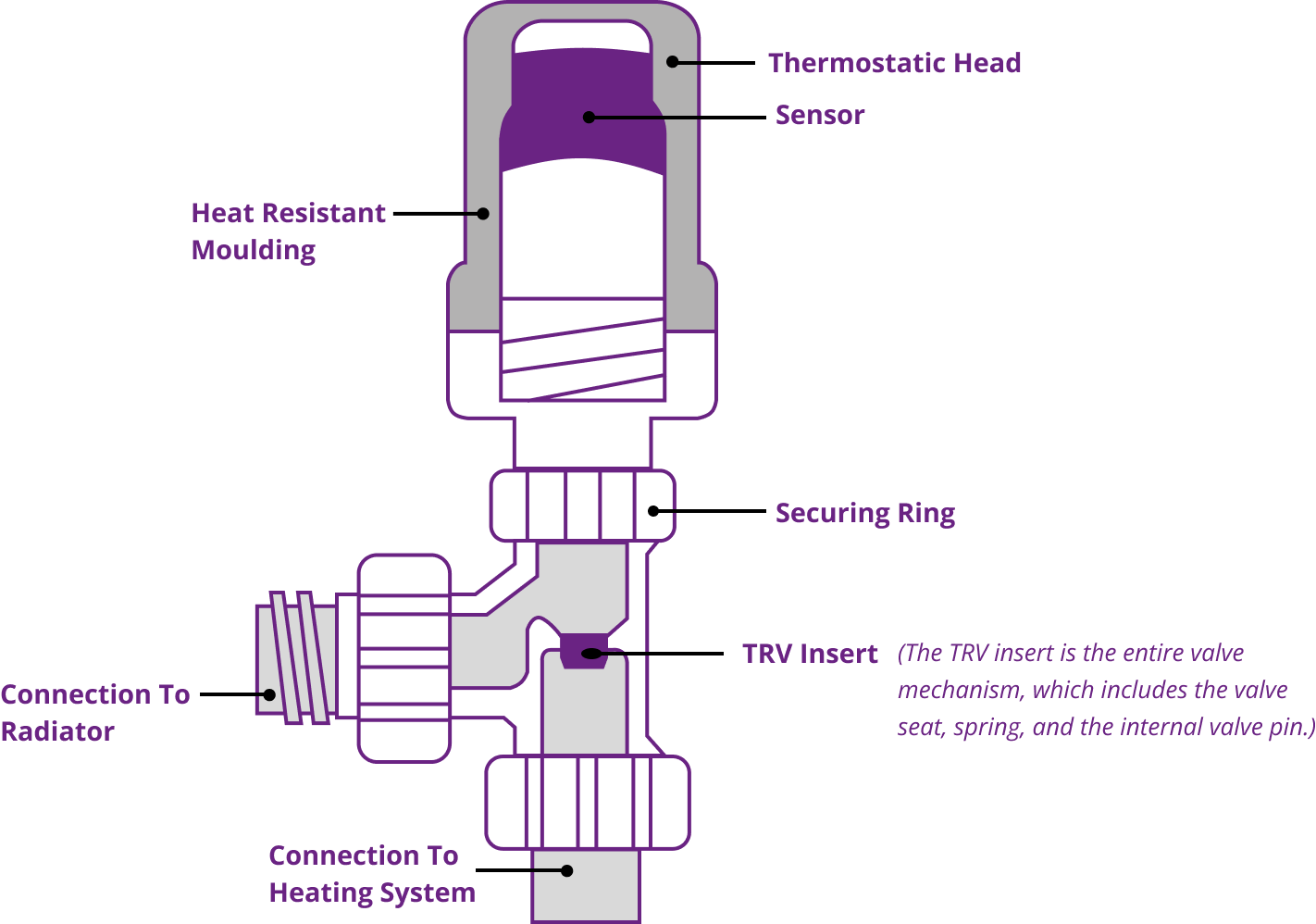
How Do Thermostatic Radiator Valves (TRVs) Work?
What’s the difference between a TRV Insert and the Internal Valve Pin?
The TRV insert is the entire valve mechanism inside the TRV body, which includes the valve seat, spring, and the internal valve pin. It’s the part that physically controls how much hot water enters the radiator and sits inside the radiator valve body to regulates the flow when pushed by the TRV head.
The Internal Valve Pin is a small moving component inside the TRV insert. It moves up and down to physically open or close the valve, allowing or stopping water from flowing into the radiator. It’s controlled by the TRV head, which expands, or contracts based on room temperature.
They work together:
- When the room is cold, the TRV head releases pressure, allowing the internal pin to lift, opening the valve inside the TRV insert and letting hot water in.
- When the room is warm, the TRV head pushes down on the internal pin, which closes the valve inside the TRV insert, stopping hot water flow.
So, the TRV insert is the entire internal mechanism, while the internal valve pin is just one part of it that moves to control water flow.
Want to try a new style of valve? Take a look at our guide to types of radiator valves
Do Heated Towel Rails Need TRVs?
Whilst a radiator doesn’t ‘need’ a TRV to function, it is recommended on the basis that they can improve efficiency and comfort levels with a home. The same logic applies to heated towel rails – they do not necessarily need a TRV, but it is possible to have one. However, as a safety precaution, we recommend having at least one radiator in your home to have a manual valve without a TRV and commonly, this radiator tends to be the radiator (or towel rail) in the bathroom. This ensures that if the other TRVs in your home fail to open or the boiler reaches the desired temperature and activates the heat pump, water would still be able to pump through the radiator with a manual valve without causing damage to the boiler or pump.
Pro Tip For Energy Efficiency
Want to keep your home cosy without wasting energy? Set all your radiator valves between 2 and 3—this keeps things warm when you need it, without overdoing it.
Since TRVs are brilliant at controlling heating room by room, make the most of them! If you’ve got a space that doesn’t get much use (like a spare bedroom), turn the TRV down to 1 or 2. This way, it’ll only heat up if the temperature drops really low, rather than wasting energy on an empty room.
Biggest mistake? Cranking the TRV up to max when a room feels cold. It won’t heat the space any faster, and your radiator will just keep running non-stop—wasting heat and money. Instead, keep it steady, and let the system do its job!
And there you have it – TRVs in a nutshell! These little devices may not look like much, but they work wonders in keeping your home warm and efficient. Just remember, set them wisely, don’t turn them up unnecessarily, and let them work their magic. Got a TRV that’s seen better days? Or thinking about upgrading? Check out our heating services or contact our engineers for expert help to make your heating system work smarter, not harder!
Oliver Osmore has been at the helm of Happy Dog Plumbing since it became part of the Maintracts Services family, bringing with him decades of experience in plumbing, heating, and electrical services. As Managing Director of both companies, Oliver is dedicated to ensuring Happy Dog Plumbing continues its proud tradition of delivering exceptional service and innovative solutions to customers.
Oliver’s approachable nature and problem-solving expertise allow him to work closely with customers, offering tailored solutions to even the most complex challenges. He is passionate about upholding the high standards that Happy Dog Plumbing has become known for, ensuring every job is handled with professionalism and care.
Since its founding, Happy Dog Plumbing has been a trusted name in installation, maintenance, and repair services. Under Oliver’s leadership, the company thrives as part of a larger, customer-focused team, staying true to its roots while benefiting from the expanded resources of Maintracts Services.


